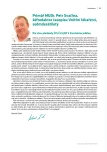Diagnosing and therapy of gout
Authors:
Karel Pavelka
Authors‘ workplace:
Revmatologický ústav a Revmatologická klinika 1. LF UK a VFN Praha
Published in:
Vnitř Lék 2015; 61(6): 517-526
Category:
Reviews
Overview
Gout is an inflammatory, metabolically conditioned crystal-induced disease. Prevalence of gout is on the increase. In clinical practice it is frequently wrongly diagnosed and the therapy of acute attacks in particular is not adequate. The first part of the publication discusses diagnostic possibilities of gouty arthritis. First of all the advantage of the analysis of synovial exudate and of direct evidence of crystals in the polarization microscope is emphasized. If the material for crystallographic analysis is not available, it is necessary to use a combination of clinical criteria as specified e.g. in the recommendations of the European League Against Rheumatism (EULAR). The second part focuses on the therapy of gout which is divided into the periods of asymptomatic hyperuricemia, acute gouty attack, intercritical and chronic tophaceous gout. Asymptomatic hyperuricemia is only treated when uricemia greater than 540 µmol/l occur repeatedly, or when other risk factors and comorbidities are present. In the treatment of acute gouty attack its early start is more important than the choice of a preparation. Alternatives are NSA, colchicine or glucocorticoids. A newly registered medicine for the treatment of refractory acute inflammation is the IL-1 inhibitor canakinumab. The treatment of hyperuricemia involves regimen and diet measures, abstinence and hypouricemic therapy. Available are the xanthine oxidase inhibitors, allopurinol and febuxostat; the latter is better suited for patients with moderate renal insufficiency. A new medicine for the treatment of severe refractory tophaceous gout is pegloticase.
Key words:
gouty arthritis – colchicine – nonsteroidal antirheumatic drugs
Sources
1. Mikuls TR, Farrar JT, Bilekr WB et al. Gout epidemiology: results from the UK General Practise Research Database 1990–1999. Ann Rheum Dis 2005; 64(2): 267–272.
2. Zhu Y, Pandya BJ, Choi HK. Prevalence of gout and hyperuricemia in US general population: the National Health and Nutrition Examination Survey 2007–2008. Arthritis Rheum 2011; 63(10): 3136–3141.
3. Wallace SL, Robinson H, Masi AT et al. Preliminary criteria for the classification of acute arthritis of gout. Arthritis Rheum 1977; 20(3): 895–900.
4. Zhang W, Doherty M, Pascual E et al. EULAR evidence based recommendations for gout. Part I: Diagnosis. Report of task force of the standing committee for international clinical studies including therapeutics (ESCISIT). Ann Rheum Dis 2006; 65(10): 1301–1311.
5. Khanna D, Fitzerald JD, Khanna JP et al. 2012 American College of Rheumatology Guidelines for Management of gout. Part 1, Systematic non-pharmacologic and pharmacologic therapeutic approaches to hyperuricemia. Arthritis Care Res 2012; 64(10): 1431–1446.
6. Patrono C. Nonsteroidal anti-inflammatory drugs. In: Hochberg MC, Silman AJ, Smolen JS et al. Rheumatology. 2-Volume Set. 4th ed. Elsevier-Mosby 2008: 403–410. ISBN 978–0323033640.
7. Schumacher HR, Boice JA, Daikh DI et al. Randomised double blind trial of etoricoxib and indometacin in treatment of acute gouty arthritis. BMJ 2002; 324(7352): 1488–1492.
8. Ahern MJ, Reid C, Gordon TP et al. Does colchicin work? Results of the first controlled study in acute gout. Aust NZ Med J 1987; 17(3): 301–304.
9. Fernandez C, Noguera R, Gonzales JA et al. Treatment of acute attacks of gout with a small dose of intraarticular triamcinolon acetonide. J Rheumatol 1999; 26(10): 2285–2286.
10. Schlesinger N, Alten RE, Bardin T et al. Canakinumab for acute gouty arthritis in patients with limited treatment options: results from two randomised, multicentre, active controlled, double blind trials and their initial extensions. Ann Rheum Dis 2012; 71(11): 1839–1848.
11. Perez-Ruiz F, Calabozo M, Pijaan J et al. Effect of urate lowering therapy on the velocity of size reduction of tophi in chronic gout. Arthritis Rheum 2002; 47(4): 356–360.
12. Choi HK. A prescription for lifestyle change in patients with hyperuricemia and gout. Curr Opin Rheumatol 2010; 22(2): 165–172.
13. Arrelano F, Sacristan J. Allopurinol hypersensitivity syndrome: a review. Ann Pharmacother 1993; 27(3): 337–343.
14. Jordan KM, Cameron JS, Snaith M et al. British Society for Rheumatology and British Health Professionals In Rheumatology guideline for the management of gout. Rheumatology (Oxford) 2007; 46(8): 1372–1374.
15. Becker MA, Schumacher HR, Wortmann RL et al. Effects of febuxostat versus allopurinol and placebo in reducing serum urate in subjects with hyperuricemia and gout: a 28-week, phase III, randomized, double-blind, parallel-group trial. Arthritis Care Res 2008; 59(11): 1540–1548.
16. Pavelka K. Doporučení České revmatologické společnosti pro léčbu dnavé artritidy. Čes Revmatol 2012; 20(2): 82–92.
17. Whelton A, MacDonald PA, Chefo S et al. Preservation of renal function during gout treatment with febuxostat: a quantitative study. Postgrad Med 2013; 125(1):106–114. Dostupné z DOI: <http://dx.doi.org/10.3810/pgm.2013.01.2626>.
18. Schumacher HR, Becker MA, Lloyd E et al. Febuxostat in the treatment of gout. 5 year findings of the FOCUS efficacy and safety study. Rheumatology (Oxford) 2009; 48(2): 188–194.
19. Sundy JS, Baraf HS, Yood RA et al. Efficacy and tolerability of pegloticase for the treatment of chronic gout in patients refractory to conventional treatment: two randomized controlled trials. JAMA 2011; 306(7): 711–720.
20. Wise CM. Crystal-associated arthritis in the elderly. Rheum Dis Clin North Am 2007; 33(1): 33–55.
Labels
Diabetology Endocrinology Internal medicineArticle was published in
Internal Medicine

2015 Issue 6
Most read in this issue
- Diagnosing and therapy of gout
- Alveolar echinococcosis – rare cystic disease of the liver – editorial
- Guidelines of Czech Association for Thrombosis and Haemostasis of the Czech Medical Association of J. E. Purkyně for safety treatment with new oral anticoagulants (NOAC) – dabigatran etexilate, apixaban and rivaroxaban
- “Stressful holiday” – takotsubo cardiomyopathy
